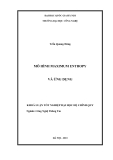
Mô hình Maximum Entropy
-
Luận văn tập trung vào tìm hiểu các mô hình học máy có giám sát phổ biến, được ứng dụng trong bài toán phân lớp quan điểm người dùng cho dữ liệu văn bản thu được từ các kênh truyền thông xã hội. Mời các bạn cùng tham khảo nội dung chi tiết.
 27p
27p  tamynhan1
tamynhan1
 13-06-2020
13-06-2020
 66
66
 6
6
 Download
Download
-
Trong luận văn, Tác giả cũng đã lựa chọn bộ phân lớp Maximum Entropy để cài đặt và thử nghiệm, đồng thời ứng dụng vào hệ thống tự động phân tích dữ liệu truyền thông xã hội trực tuyến phục vụ quản lý và hỗ trợ ra quyết định trong lĩnh vực đào tạo cho Đại học Quốc gia Hà Nội.
 8p
8p  tamynhan1
tamynhan1
 13-06-2020
13-06-2020
 49
49
 4
4
 Download
Download
-
Trong những năm gần đây, với sự phát triển mạnh mẽ của công nghệ thông tin và nhu cầu sử dụng Internet của tất cả mọi người trên thế giới đã làm tăng vọt lượng thông tin giao dịch trên Internet. Vì vậy mà số lượng văn bản xuất hiện trên Internet tăng nhanh chóng mặt cả về số lượng và chủ đề. Với khối lượng thông tin đồ sộ như vậy,
 60p
60p  chieu_mua
chieu_mua
 28-08-2012
28-08-2012
 113
113
 38
38
 Download
Download
CHỦ ĐỀ BẠN MUỐN TÌM
















